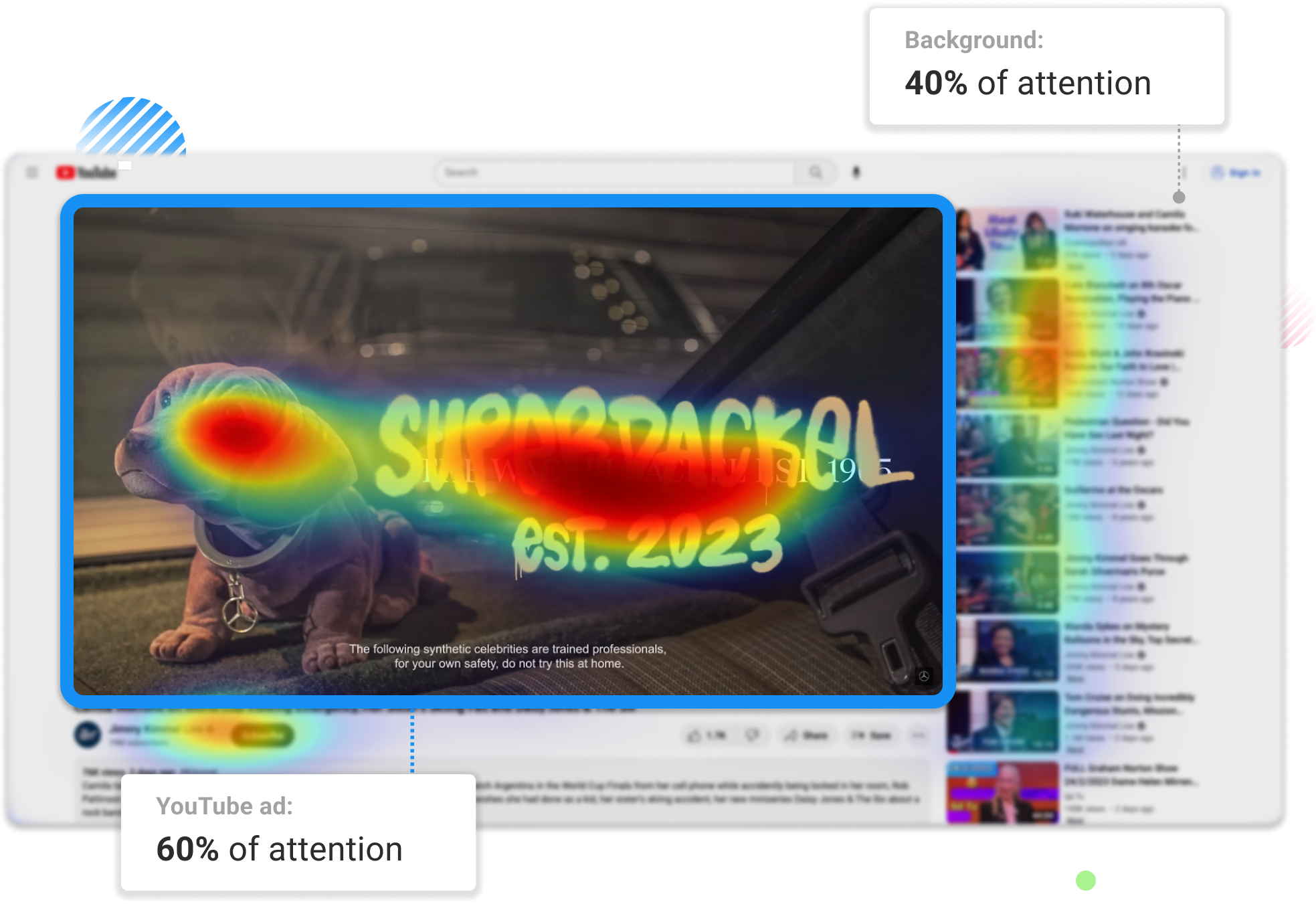Picture this; another quarter has come around and it’s time to plan your upcoming marketing campaign. You’re trying to balance your communication efforts across a multitude of different channels, but you simply don’t have the time and resources you would like to dedicate to each of them. You know you have to run ads, as they have shown promising results for you in the past, but how can you make your ads better each time?
Of course, there are many tried and tested methods to answer this question. You can work with experienced agencies, but how do you know if their ‘creative concept’ will translate into a better ROI for your campaign? Perhaps you could go down the route of conducting market research or a neuromarketing study, but these are very time-consuming and require a significant amount of resources.
In this blog post, we’ll be covering how you can use attention prediction platforms as a scalable and cost-effective way to pre-test your social media, display and YouTube ads.
What is Ad Testing, and Why is it Important?
Ad testing as a concept might seem pretty intuitive. But when we talk about attention prediction, sometimes it can get a little confusing. So we wanted to clarify exactly what we’re talking about here.
Ad testing using an attention prediction platform is all about answering the essential question: Will your ad be noticed? And if it does, will people see the most critical element(s)?
This is by no means a new question. It’s one that marketers and advertisers have been struggling with for decades. Thanks to our experience with our Neuromarketing parent company Alpha.One, we have been able to utilise neuroscientific measurement techniques such as EEG and eye-tracking to optimise ad performance. Through the years, we have been able to identify what works and what doesn’t when it comes to getting attention. But this always comes with the caveat of cost and long waiting times to generate insights. Thanks to great recent innovations in the fields of AI and computer vision, we are now able to predict with 94% accuracy what visual stimuli people will notice in any image or video - in a matter of seconds. This is a crucial element to test when preparing a successful ad campaign, because of course, if people don’t notice your ad - how will they remember it?
Testing Social Media Ads
Social media platforms are one of the most challenging platforms to grab the attention of your audience. There’s so much content being displayed, and people are scrolling so quickly it’s easy to get ignored. So how can you ensure that your ad will get noticed?
The key to success in social media is the ability of your ad to break through the clutter. You want to ensure that the ad is attention-grabbing enough to stand out from its surroundings. Typically, this would involve a lot of guessing and slow testing. But thanks to attention prediction you can test multiple iterations of your ad in seconds.
Take this Cyberpunk ad shown below. As mentioned in this IGN article, Cyberpunk lead environment artist Michal Janiszewski mentioned that this bright yellow colour in particular has become extremely popular in Poland thanks to its ability to grab attention.

So let’s say we want to run a Cyberpunk ad on Instagram. We’ve created a couple of variations of the ad and we want to know which will get more attention. The first thing we need to do now is to jump on Instagram and get a screenshot of the news feed so we know what kind of context our ad will be displayed in. Then, we need to place our ad within the context, so it can be tested relative to its surroundings. This can be done with most editing software like Photoshop or Canva, but a good free solution is Figma. Pro tip: expoze.io also has a Figma plugin!

Once we have placed the two ad variations in the Instagram context, we can start testing them. Since we used Figma for this, we were able to test these designs using the expoze.io Figma plugin.

As you can see, the yellow version is receiving more attention on the heatmap. We’ve even checked this with the Areas of Interest (AOI) feature on the expoze.io web app, and we can see that it is receiving 30% of attention compared to 26% from the darker version on the right.
So, we can conclude that the yellow will therefore capture more attention of viewers in the news feed, and is, therefore, more likely to be noticed and be an effective ad!
Testing Display Ads
While Display ads might seem similar to social media ads in concept, they are an entirely different challenge and have very different strategies for success. One of the most important things to note about display ads is the idea that people generally don’t like ads. According to emarketer, consumers feel that advertisements are too intrusive, and that ad platforms can get carried away by overwhelming them with ads to the point that they even install ad blocking software. A study from SmartInsights confirmed the relatively low success rate, by finding that display ads have an average CTR of around 0.1%.
One of the best ways to improve performance with display ads is relevance. Consumers are less likely to be frustrated if they are delivered content that is interesting and genuinely helpful or appealing to them. One of the best ways to do this is by personalising ads based on contextual cues and then automating at scale. However, when you personalise at scale - you end up with an exponentially larger set of ad variations within your display ads. But with all this dynamic content, how can you ensure that your ads are still grabbing visual attention? Fortunately, you can test them quickly!
If you have an idea of what kind of audience you will be targeting, try to find some example pages that they might visit (e.g. TechCrunch for tech enthusiasts) and repeat the same exercise as for Instagram by placing your display ads in the banner areas of the site.
In this example, you can see there are two variations of a SEMRush display ad on TechCrunch. We tested both with expoze.io, and found that for the top banner, the variant on the right received 31.8% of the attention, compared to only 24.3% of attention to the variant on the left. That’s a 30% relative increase in attention, just for making a few simple design changes!

Testing YouTube Ads
Testing YouTube (video) ads is a slightly different challenge to social media and display ads. Unfortunately, it’s not quite as simple as drawing an AOI on an image and seeing how much attention is going to a certain element. Fortunately, thanks to our close relationships with Neuromarketing research company Alpha.One and the Rotterdam School of Management, we have been able to identify a couple of key effectiveness drivers that you can test with expoze.io, based on solid Neuromarketing principles.
Driver #1: Brand attention
When your brand is activated while viewing an ad, memory associations with the brand are built in the brain. The stronger and more numerous the connections with the brand, the more that given brand becomes top of mind. The stronger the associations, the bigger the effect on sales. So, when testing your video ad, try to ensure that the brand is clear and receives plenty of attention - particularly at the beginning and end of the ad. See the below example from Lancôme - the perfect way to combine branding with outstanding creative content!

Driver: #2 Cognitive ease
Cognitive ease refers to how the strength and number of visual attention areas affect visual complexity. When there are many competing areas drawing visual attention, this reduces the ease of processing. Also, when there are abrupt scene changes, cognitive ease is decreased. A good video ad can guide attention in a split second, to enable the processing of the information under fast viewing conditions. Take a look at the image below as an example - the ad on the left is simple and clear with one point of attention - this is great in terms of cognitive ease and makes it easily digestible for the viewer. However, the example on the right has a lot of different points of attention, or visual clutter, making the viewer feel overwhelmed and harder to remember the key message.

P.S: Stay tuned for exciting updates regarding cognitive ease and brand attention scores in expoze.io!
3 Tips and Reminders for Ad testing
Now we’ve covered a few ways to test your online ads with an attention prediction platform, you should be well equipped with the knowledge you need to dive in. But before you get started, we have 3 key tips for you to make sure you can run your best pre-test:
Tip 1: Always try to test your ad in context. Attention varies a lot depending on the location of the ad, so try to perform your test in a realistic way by creating your heatmap within the real context of where you want your ad to appear.
Tip 2: Make sure you have a clear goal or objective you want to test. Avoid uploading your ad and expecting that the heatmap will tell you exactly what to do. Use it to confirm your design hierarchy and validate that the most important elements are getting the most attention.
Tip 3: Avoid the corner of death at all costs. Designers seem to love the idea of putting a logo in the corner of an ad, but actually, it’s quite often completely missed as not much attention will be paid to the corners of the ad. Just take a look at the example below.

So now you should know all you need to start testing your online ads with an attention prediction platform. Want to try it yourself? Get started! Try out your first 5 images for free.


.png)
.png)
.png)


